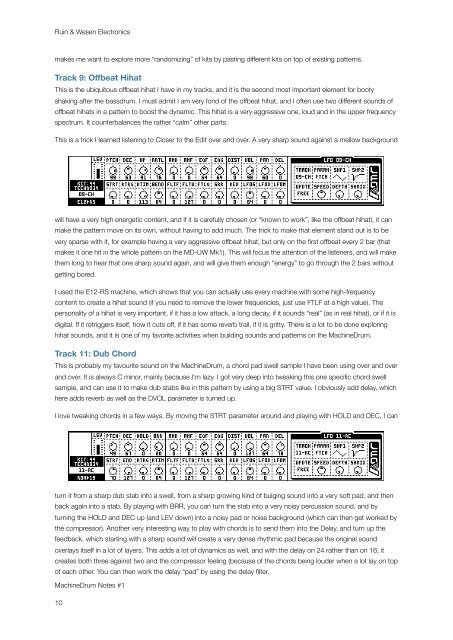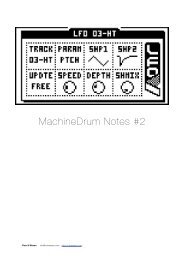MachineDrum Notes #1 - Ruin & Wesen
MachineDrum Notes #1 - Ruin & Wesen
MachineDrum Notes #1 - Ruin & Wesen
Create successful ePaper yourself
Turn your PDF publications into a flip-book with our unique Google optimized e-Paper software.
<strong>Ruin</strong> & <strong>Wesen</strong> Electronics<br />
makes me want to explore more “randomizing” of kits by pasting different kits on top of existing patterns.<br />
Track 9: Offbeat Hihat<br />
This is the ubiquitous offbeat hihat I have in my tracks, and it is the second most important element for booty<br />
shaking after the bassdrum. I must admit I am very fond of the offbeat hihat, and I often use two different sounds of<br />
offbeat hihats in a pattern to boost the dynamic. This hihat is a very aggressive one, loud and in the upper frequency<br />
spectrum. It counterbalances the rather “calm” other parts.<br />
This is a trick I learned listening to Closer to the Edit over and over. A very sharp sound against a mellow background<br />
will have a very high energetic content, and if it is carefully chosen (or “known to work”, like the offbeat hihat), it can<br />
make the pattern move on its own, without having to add much. The trick to make that element stand out is to be<br />
very sparse with it, for example having a very aggressive offbeat hihat, but only on the first offbeat every 2 bar (that<br />
makes it one hit in the whole pattern on the MD-UW Mk1). This will focus the attention of the listeners, and will make<br />
them long to hear that one sharp sound again, and will give them enough “energy” to go through the 2 bars without<br />
getting bored.<br />
I used the E12-RS machine, which shows that you can actually use every machine with some high-frequency<br />
content to create a hihat sound (if you need to remove the lower frequencies, just use FTLF at a high value). The<br />
personality of a hihat is very important, if it has a low attack, a long decay, if it sounds “real” (as in real hihat), or if it is<br />
digital. If it retriggers itself, how it cuts off, if it has some reverb trail, if it is gritty. There is a lot to be done exploring<br />
hihat sounds, and it is one of my favorite activities when building sounds and patterns on the <strong>MachineDrum</strong>.<br />
Track 11: Dub Chord<br />
This is probably my favourite sound on the <strong>MachineDrum</strong>, a chord pad swell sample I have been using over and over<br />
and over. It is always C minor, mainly because I’m lazy. I got very deep into tweaking this one specific chord swell<br />
sample, and can use it to make dub stabs like in this pattern by using a big STRT value. I obviously add delay, which<br />
here adds reverb as well as the DVOL parameter is turned up.<br />
I love tweaking chords in a few ways. By moving the STRT parameter around and playing with HOLD and DEC, I can<br />
turn it from a sharp dub stab into a swell, from a sharp growing kind of bulging sound into a very soft pad, and then<br />
back again into a stab. By playing with BRR, you can turn the stab into a very noisy percussion sound, and by<br />
turning the HOLD and DEC up (and LEV down) into a noisy pad or noise background (which can then get worked by<br />
the compressor). Another very interesting way to play with chords is to send them into the Delay, and turn up the<br />
feedback, which starting with a sharp sound will create a very dense rhythmic pad because the original sound<br />
overlays itself in a lot of layers. This adds a lot of dynamics as well, and with the delay on 24 rather than on 16, it<br />
creates both three against two and the compressor feeling (because of the chords being louder when a lot lay on top<br />
of each other. You can then work the delay “pad” by using the delay filter.<br />
<strong>MachineDrum</strong> <strong>Notes</strong> <strong>#1</strong><br />
10




